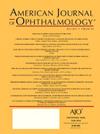视网膜血管化率预测早产儿视网膜病变,并且不受低剂量贝伐单抗治疗的影响。
IF 4.1
1区 医学
Q1 OPHTHALMOLOGY
引用次数: 0
摘要
目的:评估基于超宽视场(UWF)成像的早产儿视网膜病变(ROP)筛查的视网膜血管成形率作为1型ROP的预测因子,并表征抗vegf治疗对血管成形率的影响。设计:回顾性、连续队列研究。研究对象:平均胎龄(GA) 26.0(±2.0SD)周,出生体重(BW) 815(±264)g的早产儿76例132眼,行纵向UWF显像筛查ROP。方法:每个UWF图像上的视网膜血管化程度是用“椎间盘到颞叶血管前部”和“椎间盘到中央凹”沿着一条平分血管拱形的直线的距离之比来测量的。根据月经后年龄(PMA)绘制≥3个时间点的测量值,可以计算每只眼睛的颞血管化率(TVR)。使用TVR、GA和BW作为预测因子,创建了一个机器学习模型,将眼睛分为AB组(无ROP和2型ROP)或C组(1型ROP)。该模型在32只眼睛(19名婴儿)的保留队列中得到验证,其中8只眼睛(5名婴儿)需要治疗。比较了超低剂量(0.16 mg)玻璃体内贝伐单抗治疗前后37只眼(20名婴儿)的TVR。主要观察指标:视网膜血管化率。结果:视网膜血管化减慢与ROP严重程度增加相关,C组(n=50)眼的TVR比AB组(n=33无ROP和n=49 2型ROP)慢29% (p=0.04)。我们的模型正确地预测了30/32眼的ROP结果,达到了95.8%的平衡精度。贝伐单抗治疗前后TVR无显著变化,平均治疗后影像学随访7.7(±7.9)周(p=0.60右眼,p=0.71左眼)。结论:基于UWF成像的ROP筛查可以量化视网膜血管化率,可以提供独立于BW和GA的1型ROP的早期预测。超低剂量抗vegf治疗似乎不显著影响视网膜生理性血管化的速率,这对于高危婴儿周围无血管视网膜的发育和抗vegf干预的时机以预防疾病进展具有重要意义。本文章由计算机程序翻译,如有差异,请以英文原文为准。
Retinal Vascularization Rate Predicts Retinopathy of Prematurity and Remains Unaffected by Low-Dose Bevacizumab Treatment
PURPOSE
To assess the rate of retinal vascularization derived from ultra-widefield (UWF) imaging-based retinopathy of prematurity (ROP) screening as predictor of type 1 ROP and characterize the effect of anti–vascular endothelial growth factor (anti-VEGF) therapy on vascularization rate.
DESIGN
Retrospective, consecutive cohort study.
SUBJECTS
The study included 132 eyes of 76 premature infants with a mean gestational age (GA) of 26.0 (±2.0 SD) weeks and birthweight (BW) of 815 (±264) g, who underwent longitudinal UWF imaging for ROP screening, at a level 3 neonatal unit in Oxford, United Kingdom.
METHODS
The extent of retinal vascularization on each UWF image was measured as the ratio between “disc-to-temporal vascular front” and “disc-to-fovea” distance along a straight line bisecting the vascular arcades. Measurements from ≥3 time points plotted against post-menstrual age (PMA) enabled calculation of temporal vascularization rate (TVR) for each eye. Using TVR, GA, and BW as predictors, a machine learning model was created to classify eyes as either group AB (no ROP and type 2 ROP) or group C (type 1 ROP). The model was validated in a withheld cohort of 32 eyes (19 infants), of which 8 eyes (5 infants) required treatment. TVR in 37 eyes (20 infants) was compared before and after ultra-low-dose (0.16 mg) intravitreal bevacizumab treatment.
MAIN OUTCOME MEASURES
The rate of retinal vascularization was determined.
RESULTS
Slower retinal vascularization correlated with increasing ROP severity, with TVR being 29% slower in group C eyes (n=50) than group AB eyes (n=33 no ROP and n=49 type 2 ROP) (P = .04). Our model correctly predicted ROP outcomes of 30/32 eyes, achieving a balanced accuracy of 95.8%. No significant change in TVR was found before and after bevacizumab treatment with mean posttreatment imaging follow-up of 7.7 (±7.9) weeks (P = .60 right eyes, P = .71 left eyes).
CONCLUSIONS
UWF imaging-based ROP screening enables quantification of retinal vascularization rate, which can provide early prediction of type 1 ROP independent of BW and GA. Rate of physiological retinal vascularization does not appear to be significantly affected by ultra-low-dose anti-VEGF treatment, which has significant implications for the development of peripheral avascular retina and timing of anti-VEGF intervention to prevent disease progression in high-risk infants.
求助全文
通过发布文献求助,成功后即可免费获取论文全文。
去求助
来源期刊
CiteScore
9.20
自引率
7.10%
发文量
406
审稿时长
36 days
期刊介绍:
The American Journal of Ophthalmology is a peer-reviewed, scientific publication that welcomes the submission of original, previously unpublished manuscripts directed to ophthalmologists and visual science specialists describing clinical investigations, clinical observations, and clinically relevant laboratory investigations. Published monthly since 1884, the full text of the American Journal of Ophthalmology and supplementary material are also presented online at www.AJO.com and on ScienceDirect.
The American Journal of Ophthalmology publishes Full-Length Articles, Perspectives, Editorials, Correspondences, Books Reports and Announcements. Brief Reports and Case Reports are no longer published. We recommend submitting Brief Reports and Case Reports to our companion publication, the American Journal of Ophthalmology Case Reports.
Manuscripts are accepted with the understanding that they have not been and will not be published elsewhere substantially in any format, and that there are no ethical problems with the content or data collection. Authors may be requested to produce the data upon which the manuscript is based and to answer expeditiously any questions about the manuscript or its authors.

 求助内容:
求助内容: 应助结果提醒方式:
应助结果提醒方式:


